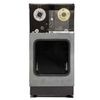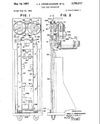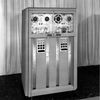1951: Tape unit developed for data storage
Univac introduces magnetic tape media data storage machine




By the late 1940s computer design engineers recognized that magnetic audio tape technology could be adapted for digital data recording. The Eckert-Mauchly Computer Corporation (EMCC) began development of a recorder that was introduced in 1951, after acquisition of the company by Remington Rand. The Uniservo 1 served as an input-output device to replace punched cards on the new Univac 1 computer. It used a 0.5 inch wide plated phosphor-bronze tape with a linear density of 128 bits per inch and a transfer rate 7,200 characters per second.
At IBM Poughkeepsie engineers experimented with moving tape at very high speeds for fast access to data. The 3M Company developed oxide particle tape to IBM specifications. James Weidenhammer and Walter Buslik designed a vacuum column that buffered a long U-shaped loop of the new tape moving at 100 to 200 inches per second to prevent breaking during rapid acceleration and deceleration.
In 1952, IBM announced its first magnetic tape storage unit, Model 726, for sale with the IBM 701 computer. It rented for $850 a month and could store 2 million digits on 8 inch diameter tape reels. Magnetic tape became the standard data storage technology of the 1950s and continues to be heavily used for archival storage of content in the entertainment industry today, as well as for other general digital storage applications where low cost is more important than fast access.
Contemporary Documents
- Welsh, H. F. and H. Lukoff. “The Uniservo-Tape Reader and Recorder” Proceedings of the Joint AIEE-IEE-ACM Computer Conference, New York (1952) pp. 47-53
- Weidenhammer, James A. and Walter S. Buslik. “Tape feed mechanism” U.S. Patent 2,792,217 (Filed: Jul 13, 1954. Issued: May 14, 1957)
More Information
- "Magnetic Tape" Revolution Exhibit Computer History Museum
- Welsh, H. F. and H. Lukoff. “The Uniservo-Tape Reader and Recorder” Proceedings of the Joint AIEE-IEE-ACM Computer Conference, New York (1952) pp. 47-53
- Weidenhammer, James A. and Walter S. Buslik. “Tape feed mechanism” U.S. Patent 2,792,217 (Filed: Jul 13, 1954. Issued: May 14, 1957)
Oral Histories
- "Masterson, Earl: An Interview Conducted by David Morton," Center for the History of Electrical Engineering, The Institute of Electrical and Electronics Engineers, Inc. (February 28, 1996)
- "Birkenstock, James W. (1912-80). Oral history interview with James W. Birkenstock," Charles Babbage Institute. (1980-08-12) [Retrieved from the University of Minnesota Digital Conservancy, http://purl.umn.edu/107118]
- "Rubens, Sidney Michel. Oral history interview with Sidney Michel Rubens," Charles Babbage Institute. (1986) Retrieved from the University of Minnesota Digital Conservancy, http://purl.umn.edu/107612.
- “IBM tape history - session 1: tape media” Computer History Museum Oral History # 102737992 (2015-10-12)
- “Rodriguez, Juan oral history” Computer History Museum Oral History # 102702129 (2009-07-13; 2009-07-15)
Fine name: 1951_TapeData_v7
Rev: 9.19.18


